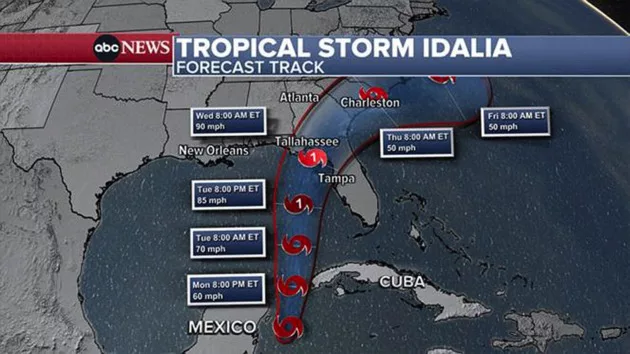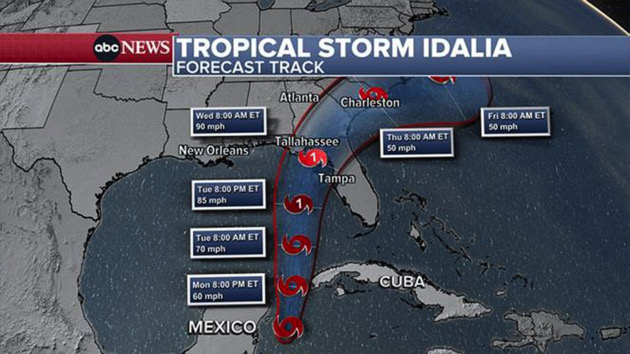
(NEW YORK) — Tropical Storm Idalia is forecast to become a hurricane on Tuesday as it continues to churn off the eastern coast of Mexico’s Yucatan Peninsula.
Idalia has maximum sustained winds of 40 mph and is moving northeast at 3 mph as of Sunday, according to meteorologists. The center of the storm is located about 95 miles from Cozumel, Mexico.
The tropical storm brought heavy rain to portions of the Yucatan Peninsula and western Cuba on Sunday afternoon.
Hurricane and storm surge watches for parts of Florida’s Gulf Coast were issued on Sunday by the National Hurricane Center.
Idalia is currently over the northwestern Caribbean Sea and will not move much over the next 12 to 24 hours. However, on Monday, the storm will begin to make a more pronounced move northward, picking up forward speed as it moves into the eastern Gulf of Mexico Monday night into Tuesday, according to weather experts.
The storm will gradually grow in strength over the next 24 to 48 hours, meteorologists said.
The current forecast calls for Idalia to make landfall sometime Wednesday morning as a Category 2 hurricane. However, some impacts will likely begin later Tuesday in some areas as the storm closes in.
Florida Gov. Ron DeSantis declared a state of emergency for 33 counties along the Gulf Coast on Saturday in response to Tropical Storm Idalia.
Leaving almost half of the state under a state of emergency, DeSantis said in a statement he “signed an Executive Order issuing a state of emergency out of an abundance of caution.”
Rapid weakening will likely begin just after landfall. However, threats of heavy rain and flash flooding will not lessen as the storm sweeps across northern Florida and up along the Southeast coast, from Georgia into the Carolinas toward the end of the week, according to meteorologists.
Widespread heavy rain is now likely for portions of the eastern Gulf Coast and Southeast, but the heaviest rainfall will be determined by the track Idalia takes as it makes landfall, according to meteorologists.
Major flash flooding is an increasing concern where the heaviest rainfall ends up happening, experts said.
Meteorologists are forecasting the biggest rain totals, about 4 to 6 inches, to happen across parts of the Florida Panhandle, northern Florida, southern Georgia and across the eastern Carolinas.
Isolated rain totals of over half a foot could occur in spots. Elsewhere, a large swath of 2 to 4 inches of rain is possible across the western Florida Peninsula and up across much of Georgia, South Carolina and North Carolina.
Rain totals could change as the main impacts from Idalia are a few days away, experts said.
In addition to Idalia, Hurricane Franklin is moving across the western Atlantic and could impact Bermuda in the coming days.
Franklin is now a Category 2 hurricane with maximum sustained winds of 100 mph and is moving to the NNW at 8 mph. The center of the storm is about 565 miles SSW of Bermuda.
Franklin will continue to strengthen over the next few days, likely reaching major hurricane strength later Sunday and could potentially strengthen into a Category 4 hurricane on Monday, according to experts.
The storm is not expected to directly impact the U.S.
Copyright © 2023, ABC Audio. All rights reserved.






